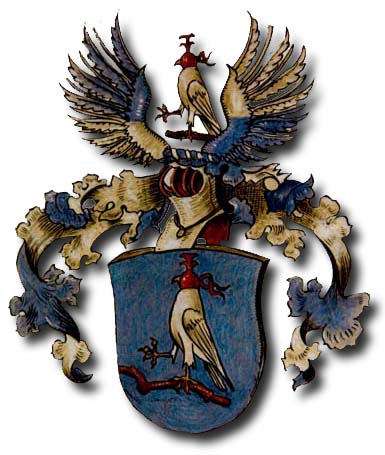
Painted 1962,
by Hanns Gerhard Otto Ludwig von Lengerken (table 165)
Painted 1962, by Hanns Gerhard Otto Ludwig von Lengerken (table 165)
We find 'house markings' or 'estate markings' as family symbols much earlier than coats of arms which originally were only marking for warfare. The house markings were isolated and were also used in coats of arms since the 14th century. Our only known house marking borne by Amelinck von Lengercke, 1620-1664, and designated by the year 1645, was to be found until World War II in a prayer chair in the St. Marienkirch in Osnabrück (fig. 1) (10).
The First authenticated family coat of arms is known to us from the Kiel council room. Its content: a falcon with hunting cowl. This allegorical coat of arms was borne by the mayor of Kiel
Ameling von Lengercken the Elder, 1536 - 1618 (tables 1, 4)
line II (fig. 2). Ameling was the third son of the ancestral father Jürgen of Osnabrück. It is not known whether or not he brought the coat of arms to kiel from his parents' house in Osnabrück.
Hunting with falcons was a royal privilege in all European and Oriental countries ranging as far as India and Egypt -- with one exception: Sweden. The art of Hunting was reserved for the feudal class which supplied itself with expensive animals from all over the world via Grand Fauconniers. It was not unusual for hunting falcons to serve as the objects of fealty.
Two sons of Ameling the Elder, namely Georg, 1569-1645 (tables 4, 14) and Ameling the Younger, 1570-1626 (tables 4, 15), as well as his daughter Margarethe, 1582-1636 (table 4), who was married to the overseas merchant Johann Füchting, bore the coat of arms in pictures, jewelry, a drawer of the Kiel council table and in epitaphs. From line I, the earliest hunting falcon coat of arms known to us is that of Johann von Lengerken, 1605-1681 (table 10) from the Nikolai Church in Kiel, today to be found in the pastor's chamber there.
All coats of arms remained unchanged as regards contents right up until today and only formally yielded to taste during the respective periods. Exceptions are shown in the following family branches of line II (see below).
Our coat of arms, recognized today as correct in terms of heraldry (as set down in Gotha in 1928) (fig. 3): Description of coat of arms: Silver hunting falcon with red cowl and right talon raised at a right angle with left talon on a brown branch growing out of the right edge of the shield. Falcon looks left and is upon a blue shield. The animal of the crest is repeated upon a helmet, turned to the side, its visor raised with the visor bars bulging, between two outspread wings, divided in blue and silver.
In the 17th century, four letters accompanied the falcon in the four corners of the shield:
P.T.S.L.
They mean:
'Post tenebras spero lucem' After the darkness hope for light.
'Post tenebras sequitur lux' After the darkness comes the light.
'Post saeculum tempora longa' After this age will come further ones.
'Pulsis tenebris satior lux' After the darkness is dispelled, brighter light follows.
The slogan of the coat of arms, on the one hand, refers literally to the removal of the hunting falcon's red cowl at the beginning of the hunt, while, on the other hand, one might surmise from it the hope for an end to post- Reformation chaos.
Changes in the coat of arms:
In the year 1636 the widow of the above-mentioned Ameling the Younger (line II) (tables 4, 15) acquired feudal land in Ausacker near Flensburg for his son Johann (Hans), 1605-1656 (tables 15, 29). The previous owner of the estate, Dietrich Jordt (Jordt means 'stag') had a springing stag carved into his church seat as was the fashion of the time (fig. 4). The new owner Johann (Hans), hereafter calling himself v. Lengern, placed his name underneath and thereby simply took over the old estate crest (fig. 4).
The Danish legislator and judicial counselor Hermann V. Kløcker, 1706-1765 (tables 64, 76), son of Elisabeth v. lengerken, d. 1718 (tables 45, 64), line II, received confirmation of his noble status and a crest from Emperor Franz I. in 1757 with the noble designation Lengercken von Kløcker and the crest of the von Kløcker family (fig. 5)
Content: a diagonal blue chevron with three gold stars upon a golden shield crowned with blue-gold ornamentation; as gem, the upper body of a man in a frock-coat in the colors of the shield's figures, swinging a bell hammer in his hand,
With Hermann Lengercken v. Kløcker's son, the sub-branch died out.
Gerhard von Lengerken, 1631-1684 (tables 25, 42), also belonged to line II. As president of the building concil and owner of Hallerup near Ljunby in Län Halland in Sweden, he was advanced in 1760 into the Swedish nobility with the name 'Leijoncrantz.' The crest bestowed in connection with this advancement to nobility shows a silver lion on blue holding a green wreath in his raised right forepaw. Upon the helmet bedecked in blue-gold, red-silver, is again found the upper part of a lion with wreath (fig. 6).
[Top of this page] [Home] [Search] [Sources]
Last edited, 10 Apr 1999 by Hans Juergen von Lengerke